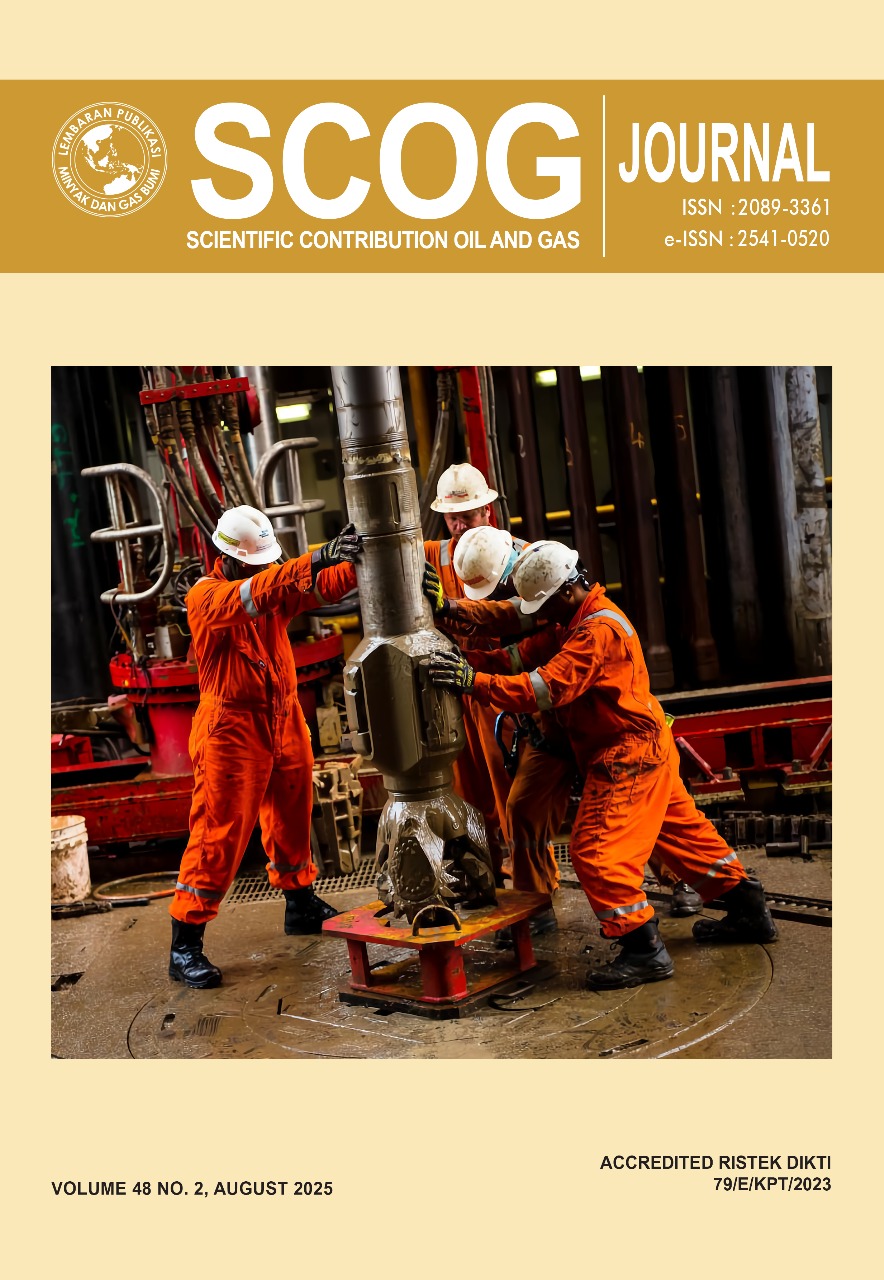The Recovery Factor Analysis on Heavy Oil Under Electromagnetic Heating Treatment
DOI:
https://doi.org/10.29017/scog.v48i2.1737Keywords:
electromagnetic, heavy oil, recovery factor, imbibition, nanopowder Ferro-oxideAbstract
The use of electromagnetic heating mechanisms in heavy oil production operations is widely limited in Indonesia. In this context, there is a need for in-depth research regarding the effectiveness of the method. Therefore, this research aimed to discuss the efficacy of heating method through Recovery Factor (RF) analysis using imbibition with electromagnetic waves and the addition of nanopowder. The results showed that the speed of heating and RF imbibition using electromagnetic waves was higher than conventional imbibition. In addition, ferrous oxide nanopowder produced the highest heating speed and RF of 38.39% below the expected value. Further research could be conducted regarding changes in the wettability of rock due to electromagnetic heating and nanopowder required to answer the problem.
References
Abdurrahman, M., Permadi, A. K., Bae, W. S., & Masduki, A. (2017). EOR in Indonesia: past, present, and future. International Journal of Oil, Gas and Coal Technology, 16(3), 250-270. https://doi.org/10.1504/IJOGCT.2017.087024
Abernethy, E. R. (1976). Production increase of heavy oils by electromagnetic heating. Journal of Canadian Petroleum Technology, 15(03). https://doi.org/10.2118/76-03-12
Afdhol, M. K., Erfando, T., Hidayat, F., Hasibuan, M. Y., & Regina, S. (2019). The prospect of electrical enhanced oil recovery for heavy oil: a review. Journal of Earth Energy Engineering, 8(2), 73-94. https://doi.org/10.25299/jeee.2019.4874
Alomair, O., & Alajmi, A. (2016, December). Experimental study for enhancing heavy oil recovery by nanofluid followed by steam flooding NFSF. In SPE International Heavy Oil Conference and Exhibition (p. D011S001R002). SPE. doi: https://doi.org/10.2118/184117-MS.
Cai, J., Chen, Y., Liu, Y., Li, S., & Sun, C. (2022). Capillary imbibition and flow of wetting liquid in irregular capillaries: A 100-year review. Advances in Colloid and Interface Science, 304, 102654. https://doi.org/10.1016/j.cis.2022.102654.
Winderasta, W., Amlan, M. H., Paksi, W. R., & Rokan, P. P. H. (2021, November). Duri steam flood fluid contacts study: redefining oil water contacts and intraformational top seals. In Join Convention Bandung (JCB).
Kovaleva, L., Davletbaev, A., & Minnigalimov, R. (2010, January). Recoveries of Heavy Oil and Bitumen Techniques With the Radio Frequency Electromagnetic Irradiation (Russian). In SPE Russian Oil and Gas Conference and Exhibition. Society of Petroleum Engineers. doi: https://doi.org/10.2118/138086-MS
Sugihardjo, S. (2013). A Study of Spontaneous Imbibition Recovery Mechanism of Surfactant Formulated from Methyl Ester Sulfonates. Scientific Contributions Oil and Gas, 36(2), 65-74. DOI: https://doi.org/10.29017/SCOG.36.2.763
Li, Y., Mason, G., Morrow, N. R., & Ruth, D. W. (2009). Capillary pressure at the imbibition front during water–oil counter-current spontaneous imbibition. Transport in porous media, 77(3), 475-487. 10.1007/s11242-008-9272-2.
Nirmala, G. S., Dewi, A. K., Halim, I., Abdassah, D., Marhaendrajana, T., & Munir, A. (2022, December). Experimental Study on Effectiveness of Microwave Heating for Heavy Oil Imbibition Process. In 2022 IEEE International RF and Microwave Conference (RFM) (pp. 1-4). IEEE. DOI:10.1109/RFM56185.2022.10065200
Nirmala, G. S., Rahmat, S., Marhaendrajana, T., & Munir, A. (2019, September). Experimental investigation on effectiveness of high power EM wave usage for decreasing heavy oil viscosity. In 2019 International Conference on Electromagnetics in Advanced Applications (ICEAA) (pp. 1193-1196). IEEE. DOI:10.1109/ICEAA.2019.8879004
Permatasari, I., Erfando, T., Satria, M. Y., Hardiyanto, H., & Astsauri, T. M. S. (2020). The Effect of Regular and Long Cyclic Steam Stimulation Method on Oil Production Performance of RUA Field in Central Sumatera. Scientific Contributions Oil and Gas, 43(1), 7-15. DOI: https://doi.org/10.29017/SCOG.43.1.525
Yang, J., Ji, S., Li, R., Qin, W., & Lu, Y. (2015). Advances of nanotechnologies in oil and gas industries. Energy Exploration & Exploitation, 33(5), 639-657. doi:10.1260/0144-5987.33.5.639
Hu, L., Li, H., & Babadagli, T. (2018, June). Property changes of formation rocks under electromagnetic heating: an experimental study. In SPE Trinidad and Tobago Section Energy Resources Conference (p. D021S015R003). SPE. doi: https://doi.org/10.2118/191238-MS
Santoso, R. K., Rachmat, S., Putra, W. D., Resha, A. H., & Hartowo, H. (2016, October). Numerical modeling of nanoparticles transport in porous media for optimisation in well stimulation and EOR using electromagnetic heating. In SPE Asia Pacific Oil and Gas Conference and Exhibition (pp. SPE-182182). SPE. doi: https://doi.org/10.2118/182182-MS
Sun, J., Wang, W., & Yue, Q. (2016). Review on microwave-matter interaction fundamentals and efficient microwave-associated heating strategies. Materials, 9(4), 231. https://doi.org/10.3390/ma9040231
Indriani, E., Rachmat, S., Mucharram, L., Gunawan, A. Y., Achmad, M., & Solida, A. (2018). The thermal encroachment of microwave heating with nano ferro fluids injection on heavy oil deposits. Modern Applied Science, 12(9), 1-1. DOI:10.5539/mas.v12n9p1
Pratama, R. A., & Babadagli, T. (2022). A review of the mechanics of heavy-oil recovery by steam injection with chemical additives. Journal of Petroleum Science and Engineering, 208, 109717. https://doi.org/10.1016/j.petrol.2021.109717.
Jannoke, L., Budi, I. S., & Pramana, A. A. (2020). Simulation Study of Hot Waterflood and WASP Injection Post Mature Steamflood. Journal of Earth Energy Science, Engineering, and Technology, 3(2).
Wan, T. (2022). Study of hybrid thermal recovery process and geomechanics on heavy oil production performance. Journal of Petroleum Science and Engineering, 218, 111007. https://doi.org/10.1016/j.petrol.2022.111007.
Wu, Z., Huiqing, L., Cao, P., & Yang, R. (2021). Experimental investigation on improved vertical sweep efficiency by steam-air injection for heavy oil reservoirs. Fuel, 285, 119138. https://doi.org/10.1016/j.fuel.2020.119138.
Yadali Jamaloei, B. (2022). Electromagnetic heating for heavy-oil and bitumen recovery: experimental, numerical, and pilot studies. SPE Reservoir Evaluation & Engineering, 25(03), 433-454. doi: https://doi.org/10.2118/209194-PA
SIVAKUMAR, Pandian, et al. Electromagnetic heating, an eco-friendly method to enhance heavy oil production: A review of recent advancements. Environmental Technology & Innovation, 2020, 20: 101100. https://doi.org/10.1016/j.eti.2020.101100.
Downloads
Published
Issue
Section
License
Copyright (c) 2025 © Copyright by Authors. Published by LEMIGAS

This work is licensed under a Creative Commons Attribution 4.0 International License.
Authors are free to Share — copy and redistribute the material in any medium or format for any purpose, even commercially Adapt — remix, transform, and build upon the material for any purpose, even commercially.
The licensor cannot revoke these freedoms as long as you follow the license terms, under the following terms Attribution — You must give appropriate credit , provide a link to the license, and indicate if changes were made . You may do so in any reasonable manner, but not in any way that suggests the licensor endorses you or your use.
No additional restrictions — You may not apply legal terms or technological measures that legally restrict others from doing anything the license permits.














